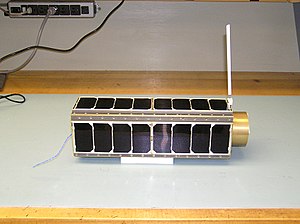GeneSat-1 is a NASA fully automated, CubeSat spaceflight system that provides life support for bacteria E. Coli K-12. The system was launched into orbit on 16 December 2006, from Wallops Flight Facility.[1] GeneSat-1 began to transmit data on its first pass over the mission's California ground station.

The GeneSat-1 satellite.
| |
| Mission type | Technology demonstration Bioscience |
|---|---|
| Operator | NASA |
| COSPAR ID | 2006-058C |
| SATCAT no. | 29655 |
| Mission duration | 21 days (planned) |
| Spacecraft properties | |
| Spacecraft type | CubeSat |
| Bus | 3U CubeSat |
| Manufacturer | Ames Research Center Stanford University |
| Launch mass | 4.6 kg (10 lb) |
| Dimensions | 10 cm × 10 cm × 34 cm (3.9 in × 3.9 in × 13.4 in) |
| Power | 4.5 watts |
| Start of mission | |
| Launch date | 16 December 2006, 12:00:00 UTC |
| Rocket | Minotaur 1 |
| Launch site | MARS, LP-0B |
| Contractor | Orbital Sciences Corporation |
| Entered service | 16 December 2010 |
| End of mission | |
| Decay date | 4 August 2010 |
| Orbital parameters | |
| Reference system | Geocentric orbit |
| Regime | Low Earth orbit |
| Perigee altitude | 413 km (257 mi) |
| Apogee altitude | 420 km (260 mi) |
| Inclination | 40.0° |
| Period | 92.9 minutes |
The nanosatellite[2] contains onboard micro-laboratory systems such as sensors and optical systems that can detect proteins that are the products of specific genetic activity. Knowledge gained from GeneSat-1 is intended to aid scientific understanding of how spaceflight affects the human body.[3]
Weighing 4.6 kilograms, the miniature laboratory was a secondary payload on an Air Force four-stage Minotaur 1 launch vehicle that delivered the Air Force TacSat-2 satellite to orbit. In the development of the GeneSat satellite class (at a fraction of what it normally costs to conduct a mission in space), Ames Research Center (Small Spacecraft Office) collaborated with organisations in industry and also universities local to the center. It is NASA's first fully automated, self-contained biological spaceflight experiment on a satellite of its size.